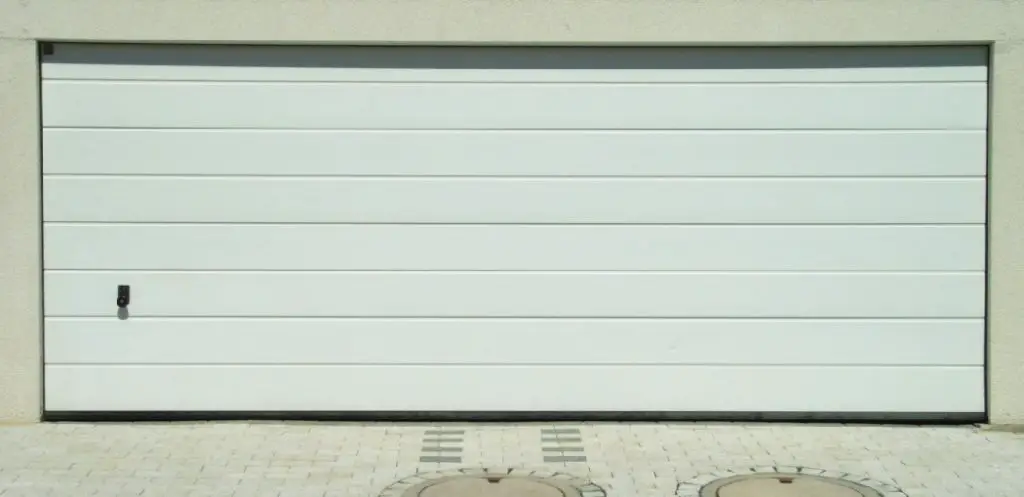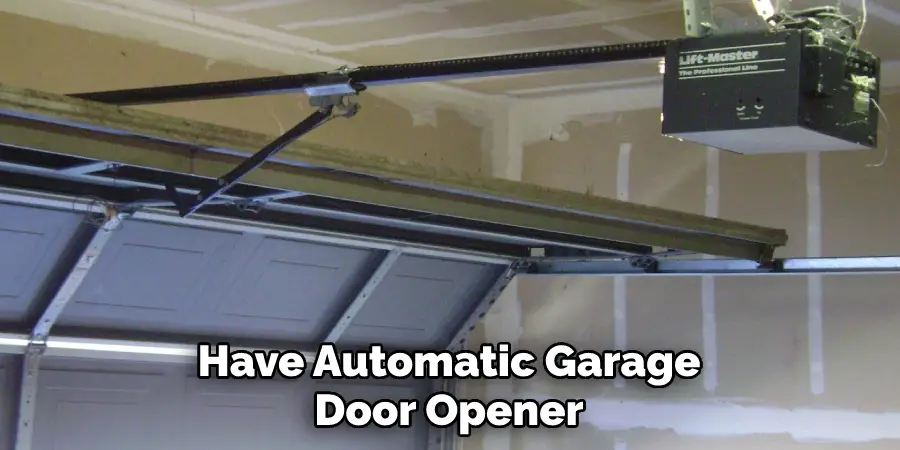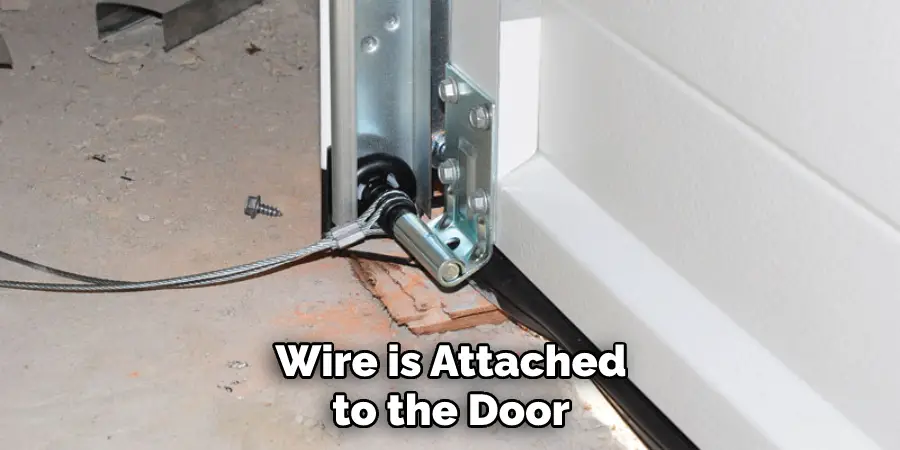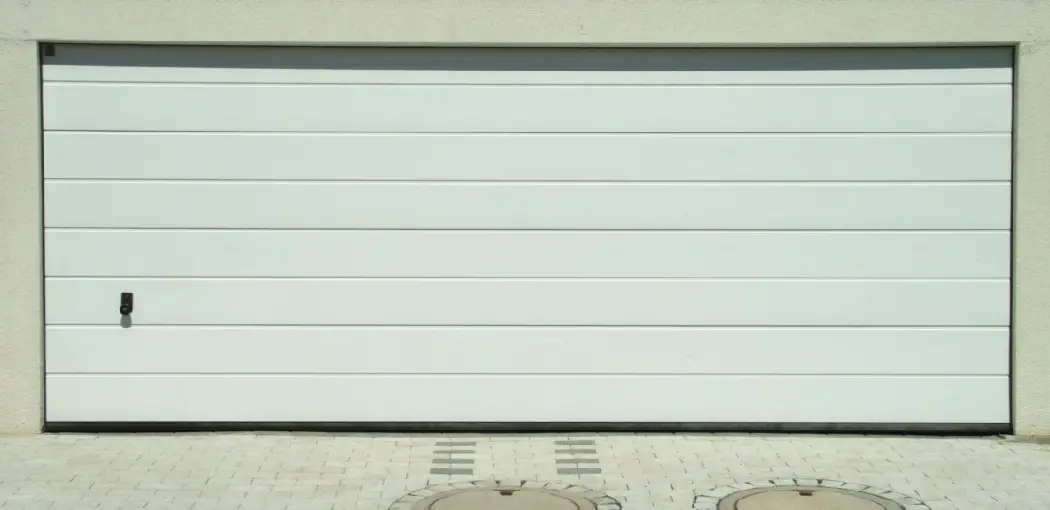If the garage door opener is broken, or there’s a power outage, and the automatic opener doesn’t work, it’s important to know how to close it manually. This can be done by disengaging the garage door from the opener carriage and then using the emergency release cord to lower the door. Keep reading to learn how to close the garage door manually in some easy steps!

Why Close the Garage Door Manually?
There are a few reasons you might want to close the garage door manually. First, if there’s a power outage, the automatic opener won’t work, so closing the garage door manually is the only way to keep your property safe and secure. Additionally, if something is blocking the door from opening all the way, closing it manually can help prevent damage.
Required Materials:
Garage Door Opener:
Make sure you have a garage door opener that includes an emergency release feature. This is typically a red cord hanging from the track of your garage door.
Ladder:
You’ll need a ladder to reach the emergency release cord and disengage the garage door from the opener carriage.
Assistant:
It’s always helpful to have someone else around when attempting to manually close a garage door. They can help hold the ladder, and it’s always better to have an extra set of hands.
How to Close the Garage Door Manually Step-by-Step Guide
Step 1: Avoid Muscle Strains
Garage doors are often very heavy, so it’s important to avoid any muscle strains when closing them. One way to do this is to use your foot to push down on the door as you close it by hand. This will help take some of the weight off of your muscles. Additionally, make sure to not force the door open or closed, as this can also lead to strains.

Step 2: Use a Piece of Wood
If you don’t have a remote or if the battery is dead, you can use a piece of wood to close the garage door. This method is a little more difficult because you have to use your body weight to push the door closed, but it will work in a pinch.
First, find a long, sturdy piece of wood. You’ll need something that is at least 8-10 feet long. Second, stand in front of the garage door and hold the piece of wood vertically.
Third, place the bottom of the wood against the garage door and use your body weight to push it closed. Fourth, hold the wood until the garage door is completely closed. Fourth, release the wood and step back.
Step 3: Prevent Electrical Shock
In order to prevent electrical shock, it is important to unplug the garage door opener before proceeding with the manual closing of the door. This can be done by locating the plug at the bottom of the opener and unplugging it from the outlet. Be sure also to disconnect the power cord from the wall outlet. If you have any questions about doing this, please consult the owner’s manual.
Now that the opener is unplugged, it is time to close the garage door manually. This can be done by grasping the door handle and pulling down on it until the door is fully closed. It is important to ensure that the door is completely closed before walking away, as there is a risk of being injured if it suddenly opens.
Once the door is closed, it is time to plug in the garage door opener and reconnect the power cord to the wall outlet. Be sure also to reconnect the plug at the bottom of the opener. Then, test the opener by pushing the button on the wall.
Step 4: Keep the Door Closed
After you have activated the manual release, it is very important to keep the door closed until the spring tension has been released. This will prevent the garage door from slamming shut and possibly injuring someone.
Step 5: Unplug Your Automatic Door Opener
If you have an automatic garage door opener, unplug it from the wall before continuing. This will prevent it from opening while you’re trying to close the door manually. You can either unplug it entirely or disconnect the power cord from the opener.
Step 6: Call a Professional when Necessary
Garage door openers are a common target for burglars. If you feel like your garage door opener is not working as it should, or if you do not feel safe having an opener installed, call a professional to have them take a look. A professional can help you decide whether you need a new opener or just a simple tune-up. They can also help you install a new opener if necessary. Remember, your safety is always the most important thing!
Step 7: If the Door Is Open, Avoid Using the Emergency Release
If the garage door is open, you should avoid using the emergency release because it will close the door with force. This can cause injury to yourself or damage to the door. Instead, try to close the door manually by pulling on the handle. If this doesn’t work, you can use the emergency release as a last resort.
Step 8: Steer Clear of The Doorway if It’s Stuck Open
If your garage door is stuck open, you will want to avoid walking through the opening. If the door falls while you are in the way, it could injure you. In addition, if the door closes on its own while you are in the way, it could crush you. So please be careful and stay clear of the door if it is stuck open.
If you have a manual garage door, you can close it by using the handle on the side. Step onto the release pedal with your left foot and pull the handle towards you with your right hand. You should be able to close the door without any problems. If the door is hard to close, you can try using some force, but be careful not to damage the door.
If you have an automatic garage door, you can close it by pressing the button on the wall or the one on your remote.
Step 9: Use the Manual Lock
If the power is out, or you want to close the door manually, you can use the manual lock. There is a small hole on the bottom right side of the garage door. Use a key or pen to turn the lock counterclockwise. The door will now be in manual mode and can be opened and closed with the regular handle.
Step 10: Watch for Irregular Movement
If you have been diligent in your inspection and lubrication of the door, it will likely move even. If you begin to notice irregular movement, stop what you are doing and investigate the cause before continuing. Perhaps one of the rollers is stuck, or debris is caught in the track. Trying to force the door open or closed could damage the door or even injury.

Perhaps one of the best ways to prevent injury is to have a family member or friend help you operate the door. You can ensure that the door moves safely and smoothly by working together.
If you are still uncomfortable with how to close the garage door manually, consider calling a professional to do it for you. This is a small task that can prevent many headaches down the road.
Garage door opener installation and repair is a common service many companies provide. However, if you have problems with your door, contact a professional for assistance. They will be able to help you get your door up and running smoothly in no time.
How to Manually Close a Garage Door From the Outside
There may come a time when you need to close the garage door manually from the outside. Perhaps the power is out, or the opener is not working. Whatever the reason, here is how to do it:
Step 1: Locate the Emergency Release Kit
The emergency release kit is a small, red handle mounted on the wall near the garage door. It is used to manually close the door in a power outage or other emergency. All garage doors have an emergency release kit that allows you to open the door manually in a power failure. The kit is usually located near the bottom of the door, near the track.
Step 2: Unlock the Emergency Release Cord
There is an emergency release cord on the side of the garage door that you can pull to release the door in case of an emergency. Locate the small black handle on the cord and pull it towards you to unlock it. The door will now be able to be opened manually.
Step 3: Unlock the Garage Door
Once the door is in the open position, you will need to unlock it before closing it. This is done by rotating the handle on the door so that the black tab lines up with the notch on the side of the door. Once it is in place, pull down on the handle to release the lock and then push up on the door to close it.
If the door is heavy, you may need to use both hands to push it up. Be careful not to let the door slam shut as this could damage the garage door opener or the door itself.
Step 4: Lift the Door
Once you have the door up, hold onto it and lift it until it is completely closed. If you have an automatic garage door opener, ensure that the door is in the down position before you close it.
Step 5: Close the Door
Once you have the spring tension relieved and the cable detached, it’s time to close the door. If you have an automatic opener, this is a good time to reset it. Stand on either side of the door and lift with the door open. Push the door closed until the rollers touch the track.
If your garage has a stop bracket installed, you will need to press the door against the stop to get it to close completely. If the door doesn’t close all the way, it may be because the tracks are dirty or the rollers need oil. Wipe down the tracks with a clean cloth and apply a light coating of garage door lubricant to the rollers. If you want to know more about how to close the garage door manually, keep reading.
Emergency Key Release Method
There may come a time when you need to close the garage door manually, and the opener is not working. In this case, you can use the emergency key release method. This involves using a key to release the door from the opener. Here’s how to do it:

Step 1: Find the Emergency Release Kit
Garage doors have an emergency release kit that can be used to open the door manually in a power outage or other emergency. The kit is typically located near the garage door opener and may be labeled.
Step 2: Unlock the Release Cord
The release cord is the small piece of rope or chain that hangs down from the garage door opener. Reach up and unlock it by pulling on the small hook. This will allow you to pull the cord down.
Step 3: Lift the Garage Door Manually
Once you have located the release handle, lift it until the garage door is fully open. You can then close the door manually by pushing it downwards. Make sure to hold onto the door as you push it down to avoid injuries. If the door starts to close on its own before you reach the bottom, pull it back up and repeat these steps.
Step 4: Close the Garage Door
Once the chain is released, you can close the garage door by pulling it down. Keep an eye on the door as it closes to ensure that nothing gets caught in between. If you have an automatic garage door opener, disable it before manually closing the door. Keep reading for more information about how to close the garage door manually.
Wire Method
If you find that your garage door opener is not working, or if it is out of power, you can close the garage door manually using a wire. This is a simple process that only requires a few basic tools.

Step 1: Prepare a Wire with One Hooked End
If you find yourself where the power is out or the garage door opener is not working, you may need to close the garage door manually. One way to do this is by using a wire with one hooked end.
Step 2: Loop the Hooked End of The Wire to The Handle
Now that the wire is attached to the door handle, you need to loop it around the hooked end. This will keep the wire in place and make it easier to close the garage door.
Step 3: Pull the Trolley Tag for The Emergency Release
The final step is to pull the trolley tag for the emergency release. This will manually open the door so that you can exit. Note that you should never use this method if you have an electric opener, as it will disable the opener.
Is the garage Door Jammed?
If your garage door is jammed and will not open, you can close it manually. The following instructions will show you how to do this:
1. Open the garage door as far as it will go.
2. Look for a release handle or cord on the garage door opener. This is usually near the garage door opener motor.
3. Pull the release handle or cord to disengage the opener.
4. Close the garage door by hand. Push down on the bar at the bottom of the door to ensure it is fully closed.
5. Reconnect the opener by pulling the release handle or cord and pushing it down on the garage door opener bar.
If you cannot close the garage door manually, or if it closes but then opens again, you should call a professional garage door technician for assistance.
Frequently Asked Question
Is It Making Noises?
If you hear some unusual noises when the garage door is in motion, it might be a sign that something is wrong. In this case, you should stop using the door and call for help. It’s best not to fix the problem yourself if you’re not sure what you’re doing. You could end up making the situation worse.
Can You Open a Garage Door Manually?
If your garage door opener is not working, you may be able to close the garage door manually. First, locate the release handle on the garage door and pull it down. Then, close the garage door by pushing it up.
Why Can’t I Open My Garage Door Manually:
There are a few reasons why you might not be able to open your garage door manually. One possibility is that the door is stuck, perhaps because of something blocking it or a broken spring. Another possibility is that the opener is not working, whether due to a power outage or another problem. You’ll need to take some corrective action to open the door in either case.
Are Garage Doors Easy to Break Into?
The answer to this question is: it depends. Some garage doors are more accessible to break into than others, but most garage doors can be easily broken into if someone knows how to do it. Most garage doors have a locking system that makes them difficult to break into.
Can You Manually Open a Garage Door With A Broken Spring?
Yes, opening a garage door with a broken spring is possible. However, it will require some extra effort. You will need to use a ladder to reach the door handle and then use your body weight to push the door open.
Conclusion
So there you have it, our simple guide on how to close the garage door manually. If you find yourself in a situation where the power is out or your electronic opener is not working; hopefully, this guide will help get the job done. Always be sure to keep a manual garage door closer on hand just in case!
You may read also How to Fix Cable on Garage Door


